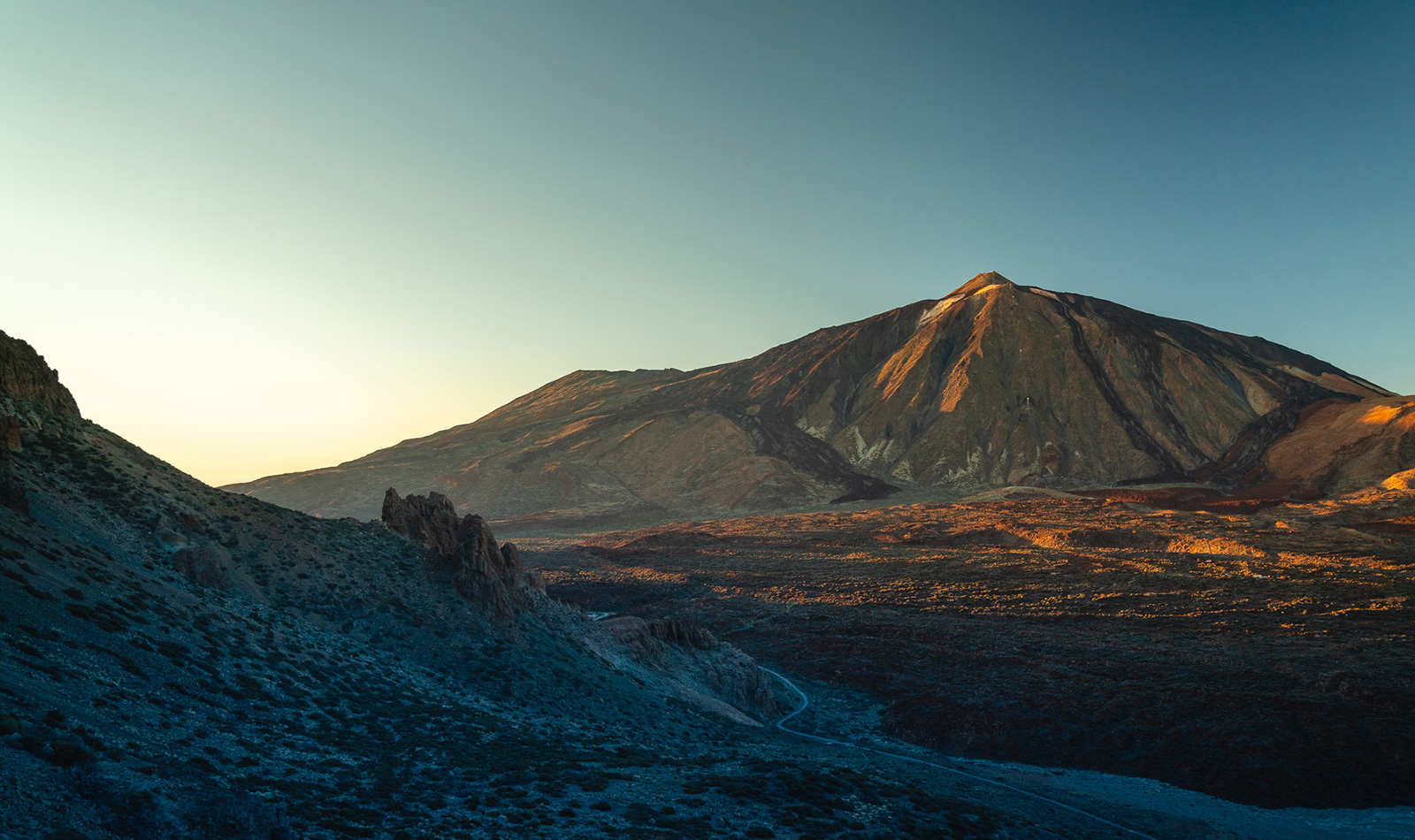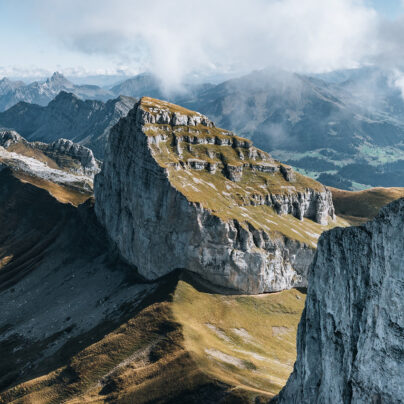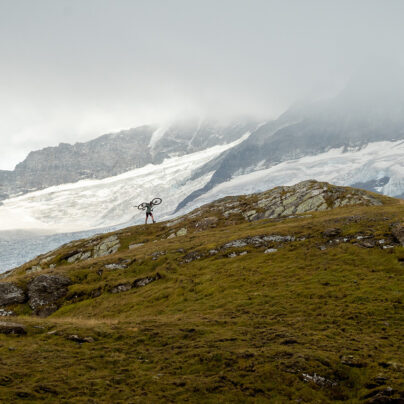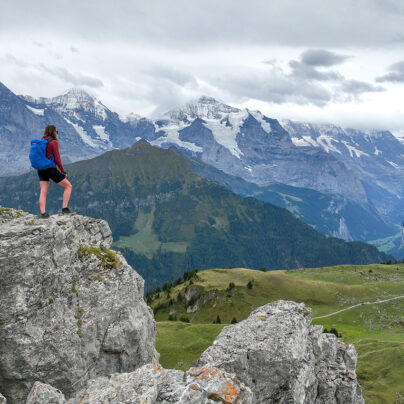Under The White Mountain
Written by Jamie Barnes
Photography by Jamie Barnes and Adriana Baez
It came over the tannoy that we would be landing soon. Excitedly I looked out of the window, hoping for a glimpse of our destination, but saw only a sea of clouds. As I felt the plane begin to descend, the crown jewel of Tenerife, El Teide, an active volcano towering at 3,718m at the heart of the island, broke through the veil below.
Before the Spanish conquered the Canary Islands in the 1400s, native tribes on the neighbouring island of La Palma gave Tenerife its name, from teni, meaning mountain, and ife, meaning white. During the winter, El Teide is occasionally covered in snow, hence ‘white mountain’.
Five million people visit Tenerife each year in search of sun, beaches, and good nightlife, yet my partner Adriana and I were here for something different. Our mutual love for wild spaces and adventure had sparked the idea for us to cross the diverse interior of the island on foot, to see the various microclimates formed by the island’s unique topography.
Carrying heavy packs and bottles of water in hand, we started our walk amongst the hectic network of holiday resorts on the island’s southern coastline. I understood why so many people were here – it was January and it felt like summer compared to what we had left behind back in England. Our first destination was the rim of a dormant ancient volcanic crater known as the Las Cañadas caldera that sits in the middle of the island, a spot that would give us a fantastic view of El Teide. The journey was two days uphill. After hours of weaving through development complexes and towns, past tempting local delicacies and ice creams, we made it to a forest of Canary Island pines halfway to the caldera. The dry landscape made campfires a strict no-no for this trip, so strict supervision of our stove’s deep blue flame was vital as we prepared our meals before calling it a day.
The following morning we woke to a warm hazy sunrise through the pine boughs. After breakfast we passed through Villaflor, the last village we would see for the majority of our journey. English was not as widely spoken as on the coast so I had to give my Spanish a go when trying to resupply our water. I definitely needed more practice; Adriana took over with her smooth local dialect before I embarrassed myself any more. As I waited outside, an elderly man with a walking stick passed by. He moved slowly and would frequently stop to study his surroundings. It made me notice how slow the pace of life was here. Quite the contrast to the hectic realm of holiday resorts we had left on the coast.




Back on the track we discovered old farmhouses dotted throughout the pine woodlands: buildings decades old with tools and equipment slowly sinking into the land as nature started to reclaim them. Due to the growing tourism trade, the farming industry in Tenerife is not what it used to be. The cost of running this high, remote farm, with water being so hard to get, probably became too much for the occupants to continue living and working here. Adriana found the skull of a goat nearby: a possible victim of the farm’s unfortunate end.
Leaving the dense pines, we moved into a landscape of peculiar rock formations and dunes of volcanic sand. At first glance they resembled the dusty surface of the moon. Warm anabatic winds began forming a sea of clouds akin to the one we saw as we flew in. As we were the only people we had seen out here, it felt like this magnificent scene was just for us. A mighty view of El Teide rewarded us as we reached the rugged cliffs of the caldera on the evening of our second day. The native people of Tenerife, the Guanches, had many myths and legends about El Teide – one of them being that it held up the sky. I could certainly see why they thought that.
It was a relief to walk down into the bottom of the caldera after our climb to reach it. Unfortunately we’d drunk more water than we’d planned. With no running water available, we had to force our aching legs even further as we made a detour to a remote hotel for a resupply. Heads turned in the pristine hotel lobby as two dust-covered backpackers trudged their way in. In hindsight we probably should have left a contribution for the mess our boots left behind as we left in search of a place to pitch up for the night. I don’t think they often received visitors like us.
The night was cold – far colder than we had anticipated at that altitude, and we certainly did not get the rest our exhausted bodies needed. Everything was crunching as we packed our ice-covered sleeping bags and tent away in the morning. Adriana’s contact lenses needed thawing from their containers. Eager to warm up, we scoffed our breakfasts and pressed on. The sun was still low in the sky and we would frequently drop in and out of its gaze as we walked the perimeter of the caldera towards the other side of the island. By the afternoon we had walked many miles and our determination to stay warm had forced quite the appetite. There were certainly worse places to enjoy lunch as the food warmed our bodies like logs in a fire.




Our morale began to feel as low as the bottom of the caldera we were walking in, but our spirits lifted when Adriana made a phone call to some friends. Her conversation sealed the chance of a hot shower and somewhere to rest our weary legs for the night at Tenerife’s astronomical observatory. Its lofty position at 2,390m above sea level on a remote island makes it the perfect spot for huge telescopes to penetrate the mysteries of the universe. That evening, after a well-deserved shower, we watched the shadow of El Teide rise as the fading sun let the sky fall into darkness. The stars burned with such clarity and depth that I started to wonder what the aboriginal inhabitants of the island thought when they looked at this same view.
Over the next few days we followed hiking trails that weaved down the mountainous spine reaching to the north-eastern corner of the island, and we left the dry, moon-like landscape behind us as we slowly moved into cooler pine woodlands. As we descended, aromatic eucalyptus trees and the dry sheddings of their bark gradually replaced the pine trees and tracks littered with pine cones and needles. Civilisation began to return as more and more cars appeared on the road we now walked, and the clusters of houses that lined them slowly turned into villages with smells of local delicacies that became harder to resist the closer our tired legs carried us to the northern coastline.
Our dusty, clammy packs hit the ground for the last time as we walked through the air-conditioned living space of the holiday apartment Adriana’s family had generously let us use in Punta del Hidalgo. After cleaning our musky clothes and washing the last of the volcanic sand from our hair, we spent the evening watching the lights of high-rise hotels come on one by one, mimicking the stars in the sky as the golden sun’s last light melted into the sea. Whilst music- and alcohol-induced cheers emanated from the streets below, the mighty silhouette of El Teide stood silent and proud across the bay. This tiny island in the middle of the ocean, which millions visit each year, still hosts some of the planet’s most spectacular and unique places – all it takes is the effort and will to witness them.
Jamie Barnes strives to share his adventures in the hope of inspiring people to get outdoors, to reconnect and learn about the natural world.
Instagram: @jamiebarnesuk
Website: jamiebarnesoutdoors.com
Adriana Baez is a travel writer and photographer from Tenerife who enjoys sharing her travels with the rest of the world.
Instagram: @adrianalibbys
Journey supported by
Fjällräven: fjallraven.com/uk/
Lowe Alpine – lowealpine.com/uk/
Firepot – firepotfood.com







